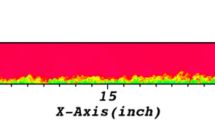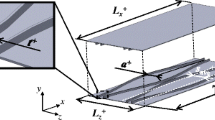Abstract
Riblets are a series of small protrusions formed along the flow direction, which have been extensively studied as a passive turbulent drag reduction technique. Experiments and numerical simulations have shown that well-designed riblets can significantly reduce drag in turbulent flows, making them highly promising and valuable for various applications. In this study, we focus on a scalloped riblet, which is designed by smoothly connecting two third-order polynomials, and thus the sharpness of the tip and the curvature of the valley can be well defined. We conduct direct numerical simulations of turbulent channel with smooth plate, scalloped riblet-mounted and triangular riblet-mounted walls. Width in wall units of W+ = 20 and height-width ratio of γ = 0.5 are selected for both riblet cases. Compared with the smooth plate case, the scalloped riblet case achieves an 8.68% drag reduction, while the triangular riblet case achieves a 4.79% drag reduction. The obtained drag reduction rate of the triangular riblet is consistent with previous experiments and simulations, and the results indicate that the scalloped riblet is more effective in reducing drag and deserves further investigation. We compare turbulent statistics of the scalloped riblet case with those of the triangular riblet case. The mean velocity profiles of riblets are similar, but both the Reynolds shear stress and second-order statistics of velocity fluctuations and Liutex are significantly reduced in the scalloped riblets controlled turbulent channel, indicating that the scalloped riblet can more effectively suppress the spanwise and wall-normal turbulent intensity near the wall. We also compare the pre-multiplied spectra of streamwise velocity and streamwise Liutex component for the three cases to investigate the energy distribution and characteristics of Liutex distribution. The Liutex vortex identification method is also utilized to analyze the instantaneous flow field, which provides insights into the flow field and could be beneficial for the further optimization of riblet.
Similar content being viewed by others
References
Abbas A., Bugeda G., Ferrer E. et al. Drag reduction via turbulent boundary layer flow control [J]. Science China Technological Sciences, 2017, 60(9): 1281–1290.
Huang Y., Wang L., Fu S. Drag reduction in turbulent channel flows by a spanwise traveling wave of wall blowing and suction [J]. Physics of Fluids, 2021, 33(9): 095111.
Xia Q. J., Huang W. X., Xu C. X. Direct numerical simulation of a turbulent boundary layer over an anisotropic compliant wall [J]. Acta Mechanica Sinica, 2019, 35(2): 384–400.
Sharma A., García-Mayoral R. Turbulent flows over dense filament canopies [J]. Journal of Fluid Mechanics, 2020, 888: A2.
Walsh M J. Riblets as a viscous drag reduction technique [J]. AIAA Journal, 1983, 21(4): 485–486.
Bechert D. W., Bruse M., Hage W. et al. Experiments on drag-reducing surfaces and their optimization with an adjustable geometry [J]. Journal of Fluid Mechanics, 1997, 338: 59–87.
Choi K. S. Near-wall structure of a turbulent boundary layer with riblets [J]. Journal of Fluid Mechanics, 1989, 208: 417–458.
Choi K. S. Near-wall structure of turbulent boundary layer with spanwise-wall oscillation [J]. Physics of Fluids, 2002, 14(7): 2530–2542.
Lee S. J., Lee S. H. Flow field analysis of a turbulent boundary layer over a riblet surface [J]. Experiments in Fluids, 2001, 30(2): 153–166.
Jiménez J., Pinelli A. The autonomous cycle of near-wall turbulence [J]. Journal of Fluid Mechanics, 1999, 389: 335–359.
Bechert D. W., Bartenwerfer M. The viscous flow on surfaces with longitudinal ribs [J]. Journal of Fluid Mechanics, 1989, 206: 105–129.
Bechert D. W., Bruse M., Hage W. et al. Fluid mechanics of biological surfaces and their technological application [J]. Naturwissenschaften, 2000, 87(4): 157–171.
Luchini P., Manzo F., Pozzi A. Resistance of a grooved surface to parallel flow and cross-flow [J]. Journal of Fluid Mechanics, 1991, 228: 87–109.
Choi H., Moin P., Kim J. Direct numerical simulation of turbulent flow over riblets [J]. Journal of Fluid Mechanics, 1993, 255: 503–539.
Garcia-Mayoral R., Jimenez J. Hydrodynamic stability and breakdown of the viscous regime over riblets [J]. Journal of Fluid Mechanics, 2011, 678: 317–347.
Wang Y., Huang Y., Fu S. On the tip sharpness of riblets for turbulent drag reduction [J]. Acta Mechanica Sinica, 2022, 38(4): 321389.
Hunt J., Wray A., Moin P. Eddies, streams, and convergence zones in turbulent flows [R]. Proceedings of the Summer Program. Center for Turbulence Research Report CTR-S88, 1988, 193–208.
Chong M. S., Perry A. E., Cantwell B. J. A general classification of three-dimensional flow fields [J]. Physics of Fluids A: Fluid Dynamics, 1990, 2(5): 765–777.
Jeong J., Hussain F. On the identification of a vortex [J]. Journal of Fluid Mechanics, 1995, 285: 69–94.
Zhou J., Adrian R. J., Balachandar S. et al. Mechanisms for generating coherent packets of hairpin vortices in channel flow [J]. Journal of Fluid Mechanics, 1999, 387: 353–396.
Liu C., Wang Y. Q., Yang Y. et al. New omega vortex identification method [J]. Science China Physics, Mechanics and Astronomy, 2016, 59(8): 684711.
Gao Y., Liu C. Rortex and comparison with eigenvalue-based vortex identification criteria [J]. Physics of Fluids, 2018, 30(8): 085107.
Liu C., Gao Y., Tian S. et al. Rortex-A new vortex vector definition and vorticity tensor and vector decompositions [J]. Physics of Fluids, 2018, 30(3): 035103.
Liu C., Gao Y. S., Dong X. R. et al. Third generation of vortex identification methods: Omega and Liutex/Rortex based systems [J]. Journal of Hydrodynamics, 2019, 31(2): 205–223.
Wang Y. Q., Gao Y. S., Xu H. et al. Liutex theoretical system and six core elements of vortex identification [J]. Journal of Hydrodynamics, 2020, 32(2): 197–211.
Wang Y. Q., Gao Y. S., Liu J. M. et al. Explicit formula for the Liutex vector and physical meaning of vorticity based on the Liutex-Shear decomposition [J]. Journal of Hydrodynamics, 2019, 31(3): 464–474.
Ding Y., Pang B. Y., Yan B. W. et al. A Liutex-based subgrid stress model for large-eddy simulation [J]. Journal of Hydrodynamics, 2022, 34(6): 1145–1150.
Gautier R., Laizet S., Lamballais E. A DNS study of jet control with microjets using an immersed boundary method [J]. International Journal of Computational Fluid Dynamics, 2014, 28(6-10): 393–410.
Acknowledgements
This work was supported by the Jiangsu Shuangchuang Project (Grant No. JSSCTD202209), the National Science Foundation of the Jiangsu Higher Education Institutions of China (Grant No. 22KJB130011).
Author information
Authors and Affiliations
Corresponding author
Ethics declarations
Conflict of interest: The authors declare that they have no conflict of interest. Yi-qian Wang is editorial board member for the Journal of Hydrodynamics and was not involved in the editorial review, or the decision to publish this article. All authors declare that there are no other competing interests.
Ethical approval: This article does not contain any studies with human participants or animals performed by any of the authors.
Informed consent: Informed consent was obtained from all individual participants included in the study.
Additional information
Biography: Zhang-danYu (2000-), Female, Master Candidate
Rights and permissions
About this article
Cite this article
Yu, Zd., Jiang, S., Yu, Hd. et al. Investigation on the vortical structures by the Liutex method in turbulent channels at Reτ = 180 with scalloped and triangular riblet control. J Hydrodyn 36, 35–52 (2024). https://doi.org/10.1007/s42241-024-0003-0
Received:
Revised:
Accepted:
Published:
Issue Date:
DOI: https://doi.org/10.1007/s42241-024-0003-0




